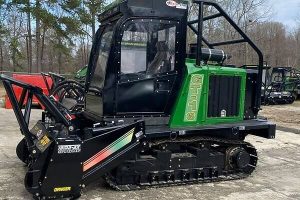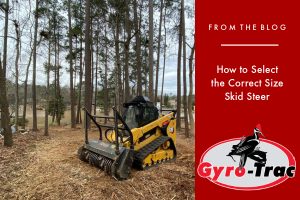Most Important Skid Steer Maintenance Items
Skid Steer Maintenance Items You Can't Forget!
Like anything, you'll get out of a skid steer what you put into it. And like any vehicle, you're going to have to perform your fair share of maintenance to ensure that your skid steer is working to its maximum potential when you're out in the field.
While there are certainly maintenance benchmarks that you should ensure you're meeting per your particular skid steer's manufacturing guidelines, there is also preventative maintenance that you'll want to perform as well - both when it comes to the vehicle itself and to any attachments that you're using.
Think of it like this: fail to properly care for your equipment and you're more likely to encounter unexpected breakdowns and issues when you're out in the field - and any unexpected breakdowns are likely to lead to lost productivity and profits. Many may even pose a safety risk.
It's why it pays - literally - to take good care of your equipment. In this post, we'll take a closer look at some skid steer maintenance you should be performing on your equipment.
What Are The Most Important Skid Steer Maintenance Items?
Unlike conventional vehicles, suggested skid steer maintenance isn't dictated on mileage - it's dictated by hours, hours that the piece of equipment has run, that is. That said, along with daily maintenance, manufacturers often suggest certain maintenance after equipment has logged a certain number of hours. Here's a look at some of those hour milestones and other maintenance considerations that you should be paying attention to:
Get Serious About Daily Maintenance
While daily maintenance is only part of a complete, comprehensive, overall maintenance plan, most agree that it's the single most important aspect of ensuring that your equipment runs better for longer. So what are some tasks that should become a part of your daily maintenance routine? Here's a look:
Check the tires: Before you get ready to fire up the engine each day, do a walk around and check out your skid steer's tires. Look for things like wear, damage, tread depth, and any obvious irregularities.
If there are any problems, tend to them immediately - as operating the skid steer on them is only going to make the problem worse. Not only that, but you don't want a tire issue causing you to get stuck out in the field.
Top off fluids: In addition to ensuring that you have a full tank of fuel for the day, you'll want to make sure that the other vital fluids are also topped off. This includes hydraulic oil, engine oil, radiator fluid, and more. When you're out in the field, the last thing you want to have to do is return to the equipment shed because you're low on one or more fluids.
Interruptions such as that, even if they are brief, are productivity killers. On a similar note, if you notice that your fluids are draining much faster than they should be, it could be the sign of a tank or hose leak or a worn seal.
Clean it: After a hard day's work in the field, a shower is usually first on your to-do list when you get home. Not only is it refreshing, but it helps rid you of any dirt and debris you may have picked up throughout the day. The same is true of your skid steer.
Your skid steer works hard in the field, and it's always a good idea to give it a thorough washing after it's done for the day. Doing so can help keep it looking good and it can also help you detect any issues that you may need to address before you fire up the engine again.
Sharpen Cutter Head Teeth
If you're working in the landscaping or forestry industries, then surely a cutter head is among the attachments that you're regularly using. These attachments are ideal for land clearing purposes, as they're able to clear brush and mulch down stumps. But as is the case with anything that regularly cuts, the "teeth" on the cutter heads are likely to dull in time. In fact, the more these attachments are used, the faster the teeth will dull. It makes sharpening important, as sharper teeth will cut faster and more efficiently. While you can sharpen manually, Gyro-Trac has invented cutter head teeth that self sharpen.
It's all thanks to a patented design that includes a self-cleaning groove, meaning you can keep your cutter head working in the field and staying productive for longer. In an industry where time equals money, being able to keep equipment operational, mulch more in a shorter period of time, and save time that would normally be needed to manually sharpen cutter teeth, self-sharpening teeth can prove to be a wise investment.
Engine and Transmission
Just as they're the two most important components in an on-road vehicle, the engine and transmission are also the two most important components in a skid steer as well. And ensuring that you're hitting maintenance milestones and keeping these two components in good working order will likely translate to long-term productivity. Good maintenance can also prevent the engine from overheating. Here's a look at some of the maintenance milestones that you should be keeping tabs on as it pertains to these two components:
250 hours: Change the engine oil and replace the oil filter for the first time. Most manufacturers also recommend changing the hydraulic filter at the 250-hour mark as well.
500 hours: Swap out the fuel filter. This is also a good benchmark to perform a more comprehensive tuneup on the vehicle, which may involve checking the chain tension and other parts and components.
1,000 hours: At this benchmark, make sure that you're flushing out the radiator, chain case oil, and the hydraulic oil and replacing it with new, fresh blends. Take the time to also flush out the engine cooling system and the final drive gear oil.
There's various other engine maintenance that should also be performed at certain hour-logged benchmarks, which include inspecting drive belts, motor mounts, engine valves, injectors and more.
Another thing to be mindful of is condensation in the fuel tank, which can happen over time. If this is the case, water should be appropriately drained from the tank or a fuel conditioner or stabilizer should be added.
On a related note, you'll also want to regularly check the appliance that serves as the key cog to starting the engine: the battery. Make sure that you're checking the battery and the battery connectors regularly, especially in cold weather, and changing it accordingly to ensure continuous operation of your skid steer.
Safety First
A skid steer is a piece of heavy equipment that's often used on busy job sites or in areas with lots of activity. Noting this, it's imperative to ensure that its safety features are in good working order, from the safety decals that should be displayed on the vehicle itself to the seat belt inside the skid steer cab. Here's what you want to be checking up on to help ensure a safe work site:
The interlock safety system, specifically that it's working so that any attachments, or the boom or bucket, doesn't function without the operator present.
Seat belts, seat belt switches, and lap bars.
The foot pedal area within the cab. Make sure it's void of any debris or buildup that could prevent proper operation.
The parking brake. Regularly test this on unlevel ground to make sure that it still functions properly.
Make Your Skid Steer Maintenance Item Checklist
Remember, what you put into your skid steer is what you're going to get out of it as far as return on investment is concerned. Don't just assume that it'll work great without any maintenance or intervention on your behalf. Take the time to brush up on your maintenance checklist today so that you can spend more time being productive and making money out in the field.



